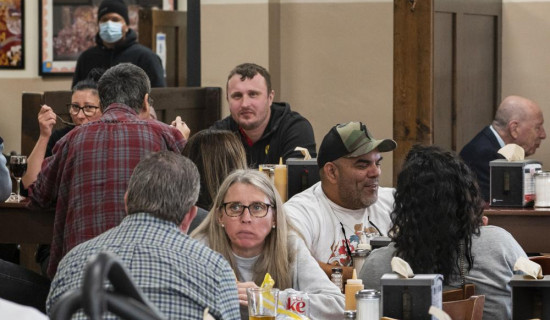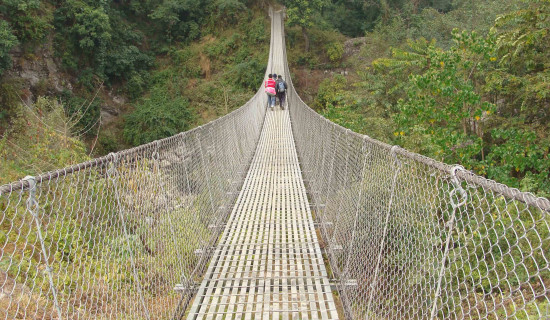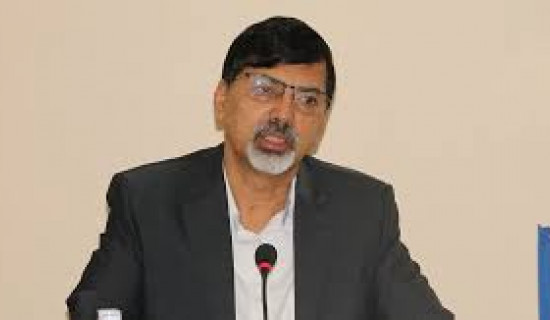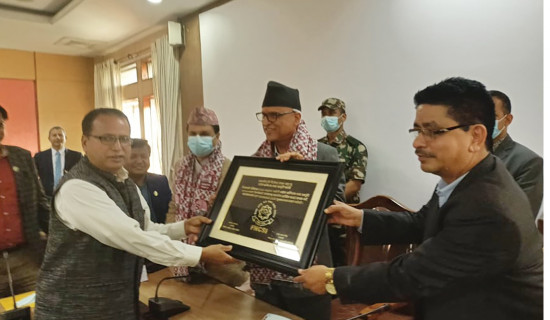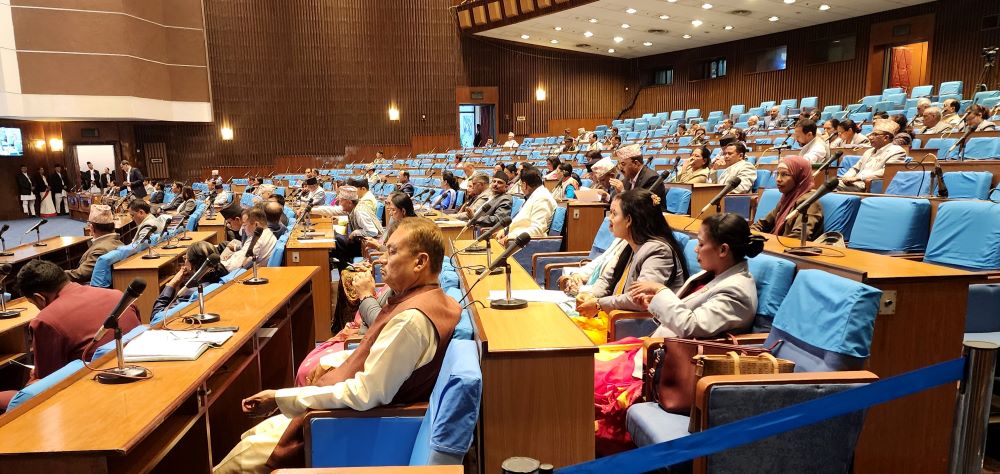- Wednesday, 3 September 2025
Climate toll on Arctic bases: Sunken runways, damaged roads
By ELLEN KNICKMEYER WASHINGTON Apr 16 , (AP) — U.S. military bases in the Arctic and sub-Arctic are failing to prepare their installations for long-term climate change as required, even though soaring temperatures and melting ice already are cracking base runways and roads and worsening flood risks up north, the Pentagon’s watchdog office said Friday.The report from the inspector general of the Department of Defense provides a rare bit of public stock-taking of the military’s state of readiness – or lack of readiness – for the worsening weather of a warming Earth.The U.S. military long has formally recognized climate change as a threat to national security. That’s in part because of the impact that intensifying floods, wildfires, extreme heat and other natural disasters are having and will have on U.S. installations and troops around the world.Increasing hurricanes, flooding, storms and wildfires in recent years have caused billions of dollars in damage to Florida’s Tyndall Air Force Base, Nebraska’s Offutt Air Force Base and other U.S. military installations, and interrupted training and other operations.For years, laws, presidential orders and Pentagon rules have mandated that the military start planning and work so that its installations, warships, warplanes and troops can carry out their missions despite increasingly challenging conditions as the use of fossil fuels heats up the Earth.While even acknowledging climate change was a career risk for administration officials under former President Donald Trump, President Joe Biden directed faster, more sweeping action on climate change by the Department of Defense and other agencies as one of his first acts in office.Despite Biden’s emphasis, inspectors visiting the United States’ six northernmost military bases last June and July found none were carrying out the required assessments and planning to prepare their installations and operations against long-term climate change.Further, “most installation leaders at the six installations we visited in the Arctic and sub-Arctic region were unfamiliar with military installation resilience planning requirements, processes, and tools,” the inspector general reports said.Senior officers told the inspector general’s inspection team that their operations lacked the training and funding to start the required work on hardening their bases. Some saw requirements for that kind of long-term planning as assembling a “wish list” that would go up against competing priorities, the officers told the inspectors.A Pentagon spokesman did not immediately respond to a request for comment Friday. The inspector general report cited Defense officials as saying that the Biden administration has finished or is working on many of the report’s recommendations to better incorporate climate preparations at bases and across military branches, and would increase resources to bases to make that possible.One of the bases is in Greenland and the other five in Alaska: Thule Air Base, Joint Base Elmendorf-Richardson, Clear Space Force Station, Eielson Air Force Base, Fort Wainwright and Fort Greely.The Arctic and sub-Arctic are important to U.S. strategic aims in part because of rising tensions and competition with Russia and China, and in part because sharply rising temperatures are melting sea ice and opening up both shipping lanes and access to the region’s oil and other resources, increasing interest and traffic in the region.The Defense Department also sees “the Arctic is a potential vector for an attack on the U.S. homeland, a region where Russia and China are operating more freely, and a strategic corridor for DoD forces between the Indo-Pacific and Europe,” the report notes.The inspectors found the kind of problems associated with worsening climate change already causing trouble at the U.S. bases.At Fort Wainwright in Alaska, heightened wildfire risks in 2019 interrupted training for two Pacific Air Force squadrons, so that one was able to carry out only 59% of planned training for a period, the report said.Many of the specific discussions of climate risks at the six bases were blacked-out in the version of the report made public Friday.But inspectors photographed and described some. That included cracked and sunken runways undermined by melting ice, damaged hangers and roads, and a collapsed rock barrier that had been piled up to hold back floodwater from a river swollen by glacial melting, at Thule in Greenland.Leaders at all six bases visited noted that kind of damage, inspectors said, “however, officials from five of these installations said they had not begun incorporating future climate risks into their installations’ planning.”“They stated that their day-to-day focus was on reacting to immediate problems or reducing risk to existing hazards, rather than planning for future hazards,” the report noted.The Arctic is warming two to three times faster than the rest of the world. A March heat wave that hiked Arctic temperatures 50 degrees (30 Celsius) higher than normal stunned scientists.Of 79 U.S. military installations overall, the Department of Defense says two-thirds are vulnerable to worsening flooding as the climate worsens and half are vulnerable to increasing drought and wildfires.
California COVID cases up, but no plans to add restrictions
By DON THOMPSON,SACRAMENTO, Calif. Apr 16 , (AP) — California has no plans to impose new statewide pandemic restrictions despite a rise in coronavirus cases primarily due to the new highly transmissible omicron variant BA.2, the state’s top health official says.The most populous state has seen “some slow but noticeable increase in our case rates” in the last 10 days, said Dr. Mark Ghaly, secretary of the California Health and Human Services Agency. California’s slower increase contrasts with some other parts of the country, especially the Northeast.Philadelphia this week became the first major U.S. city to reinstate an indoor mask mandate. Confirmed cases jumped more than 50% in 10 days and the city’s health commissioner said she wanted to intervene to head off a wave of hospitalizations and deaths.“In California, we haven’t seen a city or a county have that kind of case rate increase as of yet,” Ghaly told The Associated Press on Thursday, adding he has seen no indication local officials plan to toughen their approach. Local officials can proceed more aggressively than the state if they choose and some have during previous waves.California lifted its mask mandate in mid-February but Los Angeles County waited more than two weeks longer. And it was only two weeks ago that the city of Los Angeles ended its mandate for many indoor businesses and operators of large outdoor events to verify that customers have been vaccinated against COVID-19.In LA County, which has more than a quarter of California’s population of nearly 40 million, Public Health Director Barbara Ferrer said Thursday that cases rose 15% in the last week and she expects further increases as students return to school after spring break. But she is confident health workers and facilities are ready for any influx of seriously ill patients.“Part of responding appropriately is ensuring that we’re always well prepared for situations that may require additional safety and mitigation strategies,” Ferrer said.In mid-February California became the first state to formally adopt an “endemic” approach to the coronavirus. That plan emphasizes prevention and quick reaction to outbreaks over mandated masking and business shutdowns.California remains focused on encouraging individuals to get vaccinated and boosted, wear a mask where appropriate and take other precautions to “make good, thoughtful personal decisions to protect themselves,” Ghaly said.“This is a frequent, fast-moving situation, as it has been over the last two years, and that’s what we’re looking at. But at this moment, really no changes to our mitigation approaches across the state,” Ghaly said.Dr. Jeffrey Klausner, a professor of infectious diseases at the University of Southern California, said California’s more individualized response reflects the progress that’s been made since the onset of the pandemic two years ago prompted Gov. Gavin Newsom to impose the nation’s first statewide stay-at-home order.“In 2022 we have a variety of tools that we did not have in 2020, so it makes sense to take a different approach,” Klausner said, The goal is “to use our tools more surgically, instead of as blunt instruments like we were doing in 2020.”The BA.2 subvariant has become the dominant strain in the United States and in California in recent weeks after already spreading rapidly through Europe and Asia. California has continued relaxing precautions even as the threat of a new wave increases.On Thursday, Gov. Gavin Newsom’s administration delayed for at least a year his first-in-the-nation plan to require all schoolchildren to receive the coronavirus vaccine. Earlier this month California health officials dropped a recommendation that people quarantine themselves for at least five days if they are exposed to COVID-19, even if they have no symptoms.That’s because the virus has evolved to have a shorter incubation period of just two to three days, and usually by the time people learn they may have been exposed to someone with the virus it’s too late to head off infecting others by isolating.They also eased California’s requirement for vaccine verification or proof of negative tests for those attending indoor events with more than 1,000 people, making it a “strong recommendation.”On Friday, Los Angeles County also eased its five-day quarantine requirement. But unlike the state, it still requires people who had close contact with an infected person to get tested and wear a mask for 10 days.So far California public health officials haven’t had to trigger requirements in the state’s endemic plan to flood resources to areas with outbreaks, Ghaly said, as there are plenty of virus tests, testing sites, masks and other supplies statewide.COVID-19 hospitalizations are near record lows and intensive care patients are at their lowest levels since the start of the pandemic, allowing hospitals to reduce their use of temporary medical staff that were so vital during earlier waves.“The hospitals are in very good shape to manage even some increase in caseloads from COVID,” Ghaly said.But financially, more than half are operating at a deficit because of losses during the pandemic, the California Hospital Association said Friday. It plans to release a report next week saying losses last year were three times initial projections, on top of losses during the pandemic’s first year.About 75% of Californians are considered fully vaccinated, which health officials said is the best way to prevent severe illness, hospitalization, and death even with widespread breakthrough infections from recent variants.
Leicester fix semifinal date with Roma
APEindhoven, Apr 16 : Leicester became the first team to advance to the semifinals of the inaugural Europa Conference League after coming from a goal down to beat PSV Eindhoven 2-1 in the Netherlands.Leicester’s 2-1 aggregate victory after a 0-0 draw in the first leg sets up a semifinal match against Roma.With José Mourinho in charge, Roma is one of the favorites to win UEFA’s new third-tier competition. The Italian club got its revenge with a 4-0 victory over Norway’s Bodø/Glimt to make the semifinals 5-2 on aggregate.Ricardo Pereira scored the winner two minutes from time to earn the first European semifinals for Leicester after goalkeeper Yvon Mvogo saved substitute Patson Daka’s attempt.Eindhoven opened the scoring when former Germany international Mario Götze set up Eran Zahavi to net his eighth European goal this season and fourth in the last four Europa Conference League games.James Maddison canceled that out for Leicester in the 77th minute.At Stadio Olympic in Rome, striker Tammy Abraham opened the scoring for Roma in the fifth minute before Nicolò Zaniolo stole the show. He increased the lead to 3-0 with two goals — the first one between the legs of goalkeeper Nikita Haikin — in the span of six minutes later in the first half and completed his hat trick early in the second.Marseille won the second leg at PAOK Thessaloniki 1-0 to advance 3-1 on aggregate and meet Feyenoord in the semifinals after the Dutch club knocked out Slavia Prague 6-4 on aggregate. Cyriel Dessers scored twice to lead Feyenoord to a 3-1 victory over Slavia.
Locals await inauguration of bridge at Tamghas
By Tilachan PandeyTamas, Apr 16 : Construction of a three-way suspension bridge connecting three districts – Gulmi, Syangja, and Palpa – has been completed seven years after its foundation stone was laid.The then chief secretary of the Nepal government Lilamani Paudel and Chandra Bhandari, a Constituent Assembly member elected from Gulmi district, had laid the foundation stone for the bridge on December 1, 2014.Situated over the Kali Gandaki River in Ruru Kshetra, the bridge was expected to be completed within three years of awarding the contract to Nayabato, Rubina, Mana JV at Rs. 98.8 million on June 24, 2014.“The bridge construction has been completed after extending the deadline thrice,” said Bharat Aryal, chief at the Suspension Bridge Division Office. Locals informed that they were awaiting completion of the bridge construction for many years. “We had planned to inaugurate the bridge through Prime Minister Sher Bahadur Deuba. It is not possible now as the election code of conduct has come into effect,” said Aryal.Aryal informed that they were discussing with stakeholders to inaugurate the bridge through someone at the earliest.The major pillar of the bridge is 177.4 metres long and the three spans of the bridges are at an equal distance from the centre. It joins Rurukshetra Rural Municipality of Gulmi, Kali Gandaki Rural Municipality of Syangja and Tansen Municipality of Palpa. Authorities of the three districts and local levels have assured to work together to keep the multi-way bridge functioninal for years.
Air services resume from Suketar after three weeks
By Chandra PandakTaplejung, Apr 16 : Air services have resumed at Suketar Airport, in Taplejung district, from Friday after three weeks of obstruction.The obstruction was caused by the bad weather. “Dense fog had affected the air transportation to be operated from the airport. The weather got cleared on Friday and the services have resumed,” said Lokendra Limbu, station in charge of Nepal Airlines Corporation (NAC) in Taplejung.With the gradual improvement in the weather, three flights from Kathmandu-Taplejung took place on Friday from Suketar, informed Limbu.The obstruction had also affected tourists expecting to visit Mount Kanchenjunga. Passengers were also bound to return after waiting for hours for several days due to unfavorable weather.The NAC has been operating Kathmandu-Taplejung air services every Monday, Wednesday, and Friday from Suketar. The airport is at a height of 2,400 meters due to which the air transport service gets affected by fog.
Economy in urgent need of transformation: FM
By A Staff ReporterKathmandu, Apr 16 : Finance Minister Janardan Sharma said on Friday that the Nepali economy immediately needed transformation in agriculture and government mechanism to implement development programs. "The country is lagging in terms of development and growth and currently facing economic challenges because it has failed to manage available resources. There are challenges in utilization of the resources," he said in a meeting with the Nepal Association of Financial Journalists (NAFIJ) at his office. According to him, revolutionary changes are needed to transform the agriculture sector in order to make it able to substitute the imports that has reached Rs. 300 billion a year. The country is facing pressures on its foreign currency reserves as it is importing the goods that could be grown here. FM Sharma had initiated his budget-related discussions from agriculture. He believes that the national economy could be strengthened with the development in agriculture, reduction in the imports of petroleum fuel, increase in the generation and consumption of hydroelectricity, and attraction of tourists to Nepal. Similarly, the government mechanism to implement the development budget needs an overhaul. Although the country has been ushered to federalism, the mentality of bureaucracy and leadership is centralized which has created challenges in implementing the rights devolved to the subnational governments, he said, adding, "Reforms are needed to change this scenario. The country won’t gain much from the current structure."FM Sharma expressed worry over the high inflation rates which have severe repercussions on the foreign currency reserves, leading to economic challenges for the country. According to him, the country had paid about Rs. 100 billion for imports of petroleum products although the quantity of goods is more or less the same. Nepal imports petroleum fuel worth about Rs. 1 billion a day. Meanwhile, the government has planned to reduce the use of fossil fuel by 20 percent in its applications. Likewise, a hike in the price of goods like iron and steel, cooking oil, and vehicle spare parts had inflicted an additional burden on the balance of payment."We are also planning to shift the subsidy given to the LP gas to the electric cooking appliances in order to strengthen the national economy by reducing imports," said the finance minister. He said that his vision is to develop Nepal as a productive economy and the upcoming budget will have programs and projects to support this theme. Meanwhile, FM Sharma indicated that the claims of COVID-19 insurance would be paid in near future. However, he did not disclose the details.
Linking Heart Disease Risk With Depression
Frank Doyle , Frank For generations, people have been fascinated by the links between mind and body. For example, do people really die of a broken heart? Does a healthy mind indicate a healthy body?Scientists have been studying the associations between mental and physical health for some time. One such association is between depression and heart disease. Research has shown that depression is more common among people with heart disease compared to the general population.Further, in people who are physically healthy, when followed over many years, those with elevated depressive symptoms are more likely to develop heart disease than those who don’t have depression. We also know that in people with acute heart disease (for example, they’ve had a heart attack), having depression is associated with increased risk of further heart attacks and death, not only from heart disease, but from any cause.However, fewer studies have investigated whether these trends exist in reverse – that is, whether cardiovascular risk factors are associated with a higher likelihood of developing depression. But now, a new study published in the journal PLOS ONE has sought to explore this.Sandra Martín-Peláez from the University of Granada in Spain and her colleagues focused on people with metabolic syndrome to explore the link between cardiovascular risk factors and depression in people aged between 55 and 75.Metabolic syndrome is a group of conditions that occur together – including high blood pressure, high blood sugar, excess body fat around the waist, and elevated cholesterol – and which increase a person’s risk of heart disease, stroke, and type 2 diabetes. The participants in this study were drawn from a broader trial analysing the effects of a Mediterranean diet on people who are overweight, and who have metabolic syndrome. More than 6,500 participants were included in the baseline analysis for the study, with over 4,500 followed up two years later. The researchers used the well-established Framingham risk score, which was developed by following healthy people over time to determine the major risk factors for heart disease. Participants were asked about their depressive symptoms using questionnaires at baseline (when they began following the diets and physical activity programmes) and then two years later. Surprisingly, no significant association was found between cardiovascular risk and depression at baseline or follow-up. So, overall, participants with a higher risk of heart disease were not more likely to have or develop depression.When the authors analysed the data by gender, they found that at baseline, women with higher cardiovascular risk were more likely to show symptoms of depression. On average, all participants’ depression scores reduced at two years. Depression scores dropped more for those who had low cardiovascular risk, and for those in the intervention group (participants who were following the restricted diet and the physical activity programme).It’s difficult to clearly interpret the findings of this study. The data has been analysed in several different ways, and there are some mixed results. For example, the authors analysed the data by different metabolic syndrome factors, finding that diabetes and certain cholesterol levels resulted in lower depression scores at follow-up.Although we can’t conclude from this study that heart disease risk is associated with a higher risk of developing depression, it does add to an already strong body of evidence suggesting heart disease and depression are linked.A number of factors, behavioural and biological, may explain this relationship. Some of the biological factors common to both depression and heart disease risk include increased inflammation, constriction of blood vessels in the heart, altered autonomic nervous system activity and blood platelet dysfunction (where blood platelets are more likely to stick together and form clots).Also, we know that healthy lifestyle factors, such as doing physical activity, not smoking and maintaining a healthy diet, are protective against both heart disease and depression. The opposite is also true – unhealthy lifestyle factors are associated with increased risk of heart disease and depression.Unfortunately, people with depression find it more difficult to change these sorts of habits, for example, to quit smoking. So probably the most interesting finding of this study is that depression scores were reduced in the group who were encouraged and supported to adopt a healthier lifestyle.While there’s good evidence to suggest that exercise is a very effective treatment for depression in people with heart disease, the role of diet as an intervention for depression is less clear. This study provides a promising impetus for more investigation of diet and lifestyle as potential depression treatments in those with and at risk of heart disease.(Frank is a Senior Lecturer, Department of Health Psychology, RCSI University of Medicine and Health Sciences.)
Season Of Unity
Aashish MishraIt is spring, the season of Jatras and celebrations here in Nepal. Beginning from Holi, this season hosts some of the biggest and best-known festivals of the country, including the Ghode Jatra, the Seto and the Rato Machhindranath Jatras, the new year’s Biska (Bisket) Jatra and more. Naturally, these are occasions of joy and relaxation. They also promote social cohesion and unity.The festivals mentioned above are not exclusive to one group or community. They bring people from all walks of life together and provide an opportunity for them to share lived experiences. The Rato Machhindranath Jatra can be a great example of this.This Jatra is executed and celebrated by everyone, regardless of class, caste and religion, of the ancient core city of Patan. God Karunamaya itself is a deity worshipped with equal fervour and dedication by both Hindus and Buddhists and no one from any ethnic and economic background is restricted in any way from pulling the chariot. Women are also allowed to participate in the fun on one special day and children, too, get in on the action by pulling the chariot of Minnath.The Rato Machhindranath Jatra even connects the people of Lalitpur with Dolakha. The Newas of Dolakha also worship the god and hold a chariot festival for it around a month before Lalitpur. This helps to establish a common link between the two districts and unites the multiple Newa communities residing here around one occasion. It is a similar case with Biska which is celebrated, in one way or the other, by all Bhaktapurians as well as those in parts of Kathmandu and Thimi. Holi, also called Phagu, also does the same thing as it is celebrated by most Hindus and even non-Hindus across the country.Of course, this unifying factor is not limited to the festivals of spring only. Take for instance Indra Jatra, a festival celebrated in Autumn, the nine oil-presser (Manandhar) wards are responsible for the selection, transport and erection of the 60 feel high sacred Yansi pole, the Jyapu farmers perform the Devi Pyakha (Goddess Dance) and are involved in conducting numerous processions throughout the Jatra period, a Putuwar from Balaju keeps watch over the Yansi for eight days, a Kusle musician comes and plays the oboe at its feet every day until it is felled, Hindu Rajopadhyayas and Buddhist Bajracharyas act as priests for the images of Indra put on display at Indrachowk, Maru, Kilagal and Nardevi and the mask of the Dagi is kept at the house of a Tuladhar family near Kasthamandap. Since the ascension of Prithvi Narayan Shah to Kathmandu’s throne, various non-Newa castes have also played important roles in the successful conduction and completion of the festival. Every caste plays a vital role for the completion of the Jatra and no task is judged big or small. All those engaged in the festivity are equally important.Nepal’s festivals have crossed geographical, racial and ethnic boundaries and bonded different groups and communities for centuries. However, in recent years, they have started to become exclusionary in the economic aspect. Excess and pomp have made festivals unaffordable for the poor. Too much emphasis on materialism has prevented economically disadvantaged families from participating in and enjoying the celebrations like they used to. This has started to create resentment and dismay which is particularly visible around Dashain and Tihar. It is a sad fact of our time that festivals are only festivals for those with money. For others, it is a reminder of their lack of resources and marginalisation.However, if we get rid of ostentation then festivals, at their core, are still unifying factors for our society.
Pandemic phase of COVID-19 ending?
By A Staff ReporterKathmandu, Apr 16 : For much of the past two years, COVID-19 ruled the world, creating unprecedented challenges to health system. As public health measures, hand washing, wearing masks and maintaining social distance remained part of the new normal. On 23 January 2020, the disease was first detected in Nepal. As mitigation measures the country adopted strict restrictions. During the first wave of the pandemic, the country faced shortage of personal protective equipment including masks and PPE.The second wave, severer than the first one, began to hit the country in April 2021, leaving many patients in dire need of medical oxygen and hospitalisations. On May 11, the country recorded highest single-day coronavirus-related deaths with 225 fatalities and 9,483 new cases within 24 hours. The fragile health care system was overwhelmed. And 8,000 cases were recorded on average on a daily basis. Again, Nepal faced the emergence of the third wave in January 2022. As the new variant of the virus, Omicron, was making a comeback, on January 20, 2022, Nepal recorded an all-time daily high of over 10,200 cases through RT-PCR tests. According to the health experts, the pandemic phase of COVID-19 seems to be ending in Nepal, unless significant and severe new variant emerges. If we see the trend in the world, however, COVID-19 may emerge again, but still we may not face the worst case scenario like that of the second wave, said Dr. Sher Bahadur Pun, chief of the Clinical Research Unit at Sukraraj Tropical and Infectious Disease Hospital, Teku. There are possibilities of new variants, muted or hybrid, gripping us anytime, so we need to be alert all the time, added Dr. Pun. According to Dr. Chuman Lal Das, director at the Epidemiology and Disease Control Division, though the cases are declining significantly, everyone should remain cautions. “Nobody is safe until everyone is safe from the virus,” said Dr. Das and added that as the cases have not been eradicated from the world, no one knows for sure how it is changing its face and will emerge again anywhere and anytime. As a precautionary measure, the government is still screening people coming from abroad at the Tribhuwan International Airport, said Dr. Das. The pandemic continues to recede for the last one month in Nepal as the cases are reported in two digits or even in a single digit, thanks to the robust vaccination campaign. The government so far has vaccinated 66.3 per cent of its population. The government has done a commendable job regarding vaccination, but still many are reluctant to get the jab, said Dr. Pun and added that it was essential to get vaccinated to fight against any variant of the virus.Dr. Sangita Kausal Mishra, spokesperson for the Ministry of Health and Population (MoHP), requested all to adopt safety health protocols and receive vaccines against COVID-19 to keep the virus at bay.
Fire reduces 11 houses, 4 sheds to ashes at Tikalipur, Banke
Ein Bahadur Malla, Deputy Inspector of Police (DSP) and chief at the Area Police Office in Kohalpur, said that the fire caught many houses as it was a time of windy weather and that there was no fire engine at Raptisonari.
Small industries in government priority: Badu
BY A STAFF REPORTER, Kathmandu, Apr. 15 : Minister for Industry, Commerce and Supplies Dilendra Prasad Badu has said that micro, cottage and small scale industries are the backbone of the country's economy and the key to economic prosperity.He made this remark in an interaction with a delegation of the Federation of Nepal, Cottage and Small Industries (FNCSI) at the Ministry Wednesday.He said, "Micro, cottage and small industries are in priority of the government. This sector makes the country self-reliant and creates employment. We are ready to discuss what are the problems in this area, and what we should do for the solution.”"We felt that there are some problems in the promotion of this sector after the adoption of federalism in the country. We have to move forward by addressing the problem through the amendment to existing act and policy," he said.FNCCI President Umesh Prasad Singh said that effective implementation of the directive 2071 on the use of domestic goods in public entities should be made for the promotion of domestic goods and the development of local industries.He stressed the need to stop the import of agriculture and other industrial goods which can be produced inside the country.Stating that the state should provide structure and space for the promotion of locally produced goods and development of domestic industries at the federal and in the provinces for opening export houses, he said that arrangements should be made to keep only domestic goods produced by micro, cottage and small entrepreneurs across the country at the centre. "We request the government to keep the concessional loan programme given to women entrepreneurs, agro-industry and other entrepreneurs at 5 per cent," he said.
Two dead, four injured in Palpa bus accident
By Rekhi Ram Rana, Palpa, Apr. 15: At least two passengers have died when a bus skidded some 700 meters off the road at Juthapauwa in Rainadevi Chhahara-6 in the district.According to the police post at Juthapauwa, four passengers have been injured and they have been sent to the Mission Hospital in Tansen for treatment. The cause of the accident is yet to be known.
Nepali arts hold global identity for Nepal: VP Pun
Kathmandu, April 15: Vice President Nanda Bahadur Pun asserted that the Nepali arts held a global identity for Nepal. He said Nepal is rich in natural and cultural arts. Inaugurating the National Fine Arts Exhibhition-2079 BS at Nepal Academy of Fine Arts (NAFA) in Kathmandu today, VP Pun recalled the national luminary Araniko who, according to the VP, held the head of Nepal high abroad through arts. Expressing his happiness over the wide reach of Nepali arts across the world, Pun recalled the pride he had taken to see Nepali folk and modern arts exhibited in Austrian capital-Vienna- some years ago. Stating that Nepali arts, which had over 2,000 years of history, were being created in various genres and techniques lately unlike in traditional form in the past, he underscored the State's support in preserving and conserving the arts. The VP shared that his interest spanned the field of fine arts. On the occasion, NAFA's chancellor Kancha Kumar Karmacharya said that the exhibition would run for a month. A total of 426 paintings by 365 artists from all over the country are on display in the exhibition. VP Pun, on the occasion, awarded senior fine artist duo Krishna Manandhar and Surya Bahadur Chitrakar with 'Araniko Pragya Samman' carrying a purse of Rs 100,000 for each. Similarly, journalist Devendra Thumkeli received 'National Fine Arts Writing Award' while Sushila Tamang was awarded 'Fine Arts Journalism Award'. Also, seven artists were awarded the 'National Fine Arts Award' in different categories and 17 with 'Fine Arts Special Award'. Seven artists from seven provinces received the 'Lalitkala Provincial Award'.
14 new cases, 55 recoveries in 24 hours
Kathmandu, April 15: With 14 new cases of COVID-19 confirmed on Friday, the nation's novel coronavirus tally has reached 978,648.In 3,030 Real-Time Polymerase Chain Reaction (RT-PCR) tests done in the past 24 hours, a total of 14 persons were found infected with SARS-CoV-2, informed the Ministry of Health and Population (MoHP) in its regular update.Likewise, the virus infection was detected in zero people in 873 antigen tests performed in the last 24 hours.Currently, there are 438 active cases of COVID-19 across the nation of which, 19 are admitted to various institutional isolation while 419 patients are placed in home isolation.Of the active patients, nine are admitted to the ICU and one is under treatment with the ventilator facility.Meanwhile, 55 COVID-19 patients receiving treatment in institutional isolation or staying in home isolation recovered from the infection in the last 24 hours. Nepal has now recorded 966,259 cases of recovery, and the recovery rate is at 98.7 per cent.The MoHP on Friday added zero COVID-19 related fatalities to the nation's COVID-19 death toll, which has now reached 11,951.
Provincial, district committees of ruling parties likely to be asked to forge consensus on electoral coalition by April 13
Provincial, district committees of ruling parties likely to be asked to forge consensus on electoral coalition by April 13 NBA decides not to issue LC for import of essentialsChief Minister Rai calls for opening export-oriented industriesCPN (Unified Socialist) forms Election Mobilization Committee Influx of devotees in Muktinath (Photo Feature) Former Finance Ministers draw government's attention to economy Chief Minister Rai calls for opening export-oriented industries Provincial, district committees of ruling parties likely to be asked to forge consensus on electoral coalition by April 13Issues of price increment of petroleum goods will be resolved: Minister Badu Chinese Ambassador Hou Yanqi sings Nepali song Resham Felili Chief Minister Rai calls for opening export-oriented industries Buddhakrishna piercing his tongue for the ninth time, says it'll be his last Issues of price increment of petroleum goods will be resolved: Minister Badu We are trying to have more Nepali workers in Japan: Deputy Assistant Minister Iwamoto Three new cases, 48 recoveries in 24 hours Buddhakrishna piercing his tongue for the ninth time, says it'll be his last IAEA Says Ukraine Has Requested Help Safeguarding Nuclear Plants Buddhakrishna piercing his tongue for the ninth time, says it'll be his last 2,593 foreign tourists arrived in Nepal yesterday Three new cases, 48 recoveries in 24 hours CPN (Unified Socialist) forms Election Mobilization Committee We are trying to have more Nepali workers in Japan: Deputy Assistant Minister Iwamoto Buddhakrishna piercing his tongue for the ninth time, says it'll be his last Former Finance Ministers draw government's attention to economy Chinese Ambassador Hou Yanqi sings Nepali song Resham Felili IAEA Says Ukraine Has Requested Help Safeguarding Nuclear Plants Three new cases, 48 recoveries in 24 hours Former Finance Ministers draw government's attention to economy Provincial, district committees of ruling parties likely to be asked to forge consensus on electoral coalition by April 13

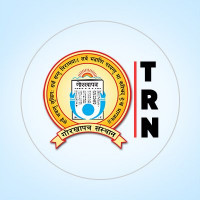
-original-thumb.jpg)
